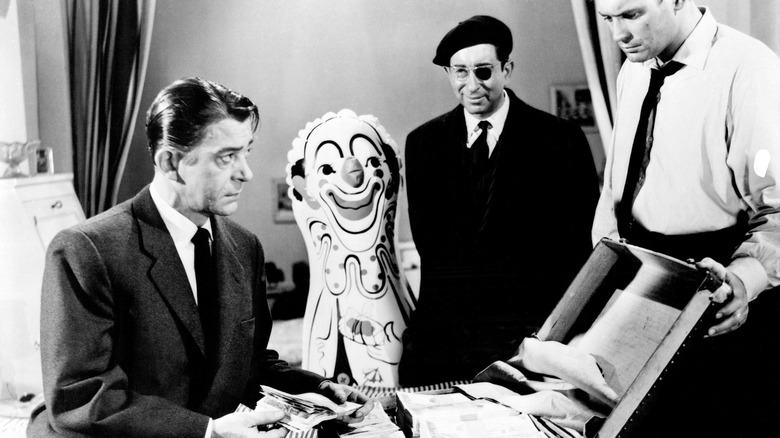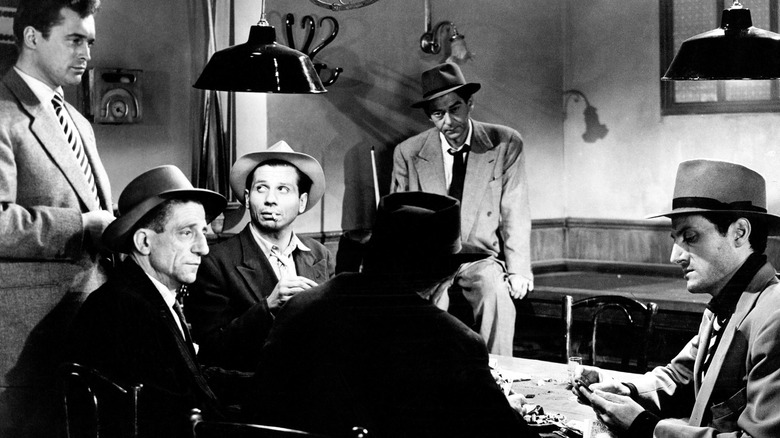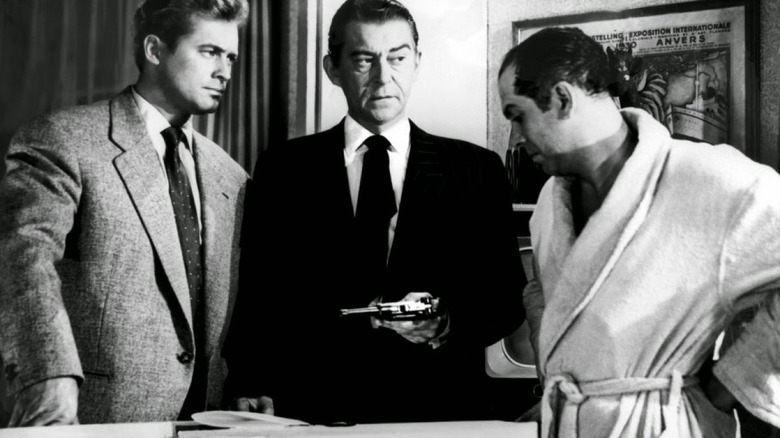Rififi's Famous Safecracking Scene Was A Little Too Realistic
Less talked about than film noir is its lighter cousin film gris, an artistic movement from the 1940s and 1950s founded to specifically criticize the American class system through the eyes of struggling criminals, thieves, and con men. Unlike film noir, which focused on a hardboiled world absent of heroes, film gris was more analytical, taking place in a more realistic version of the world, viewing crime not as a societal aberration but a natural outcropping of failed capitalism. Connecticut born filmmaker Jules Dassin was at the forefront of this movement, having made the notable film gris crime movies "Thieves' Highway" and "Night and the City" in 1949 and 1950 respectively. Although there is no record, on-paper connection between those two films and the fact that Dassin ended up on the notorious Hollywood Blacklist, it's easy to see Dassin's political bent getting him in trouble with the oust-happy House Un-American Activities Committee. Dassin's name kept coming up in HUAC hearings in the late '40s, he was fingered by fellow directed Edward Dmytryk, and he was eventually forced to flee to France in the early '50s.
In France, an admirer of Dassin's, the noir master Jean-Pierre Melville, passed on a heist project so that Dassin would finally have a film directing job, his first in five years. The project was 1955's "Rififi," aka "Du rififi chez les hommes," a film which was to set the modern template for all heist movies that were to come after. Dassin wrote the screenplay for "Rififi" with René Wheeler, who translated it into French, adapting it from the novel by Auguste Le Breton. The film wisely omitted some of the darker elements of the book (it contained racist elements, and even featured some necrophilia). Notably, Dassin expanded the heist/safecracking scene in the novel to occupy about a quarter of "Rififi's" ultimate running time, presented as a methodical, music- and dialogue-free sequence wherein the main characters (led by Jean Servais) defeat alarms, drill through a floor, and crack into a safe. Unlike more recent heist movies wherein the safecracking scene would appear at the end, Dassin put his in the middle of the film, and was just as interested in the aftermath of the characters as the mechanics of their break-in.
Indeed, the famous sequence was so detailed and so frankly presented, many critics — and local authorities — saw "Rififi" as an instructional manual on how to commit a perfect heist. Once ostracized for being a Communist, Dassin was now being banned.
The details of the heist
The heist in question is gloriously elaborate, and deeply meticulous. The central team, for instance, must defeat an alarm that is triggered by vibrations. After a few tests, they find that the bell can be dampened by squirting a foaming fire extinguisher into the alarm's casing. Brilliant. In order to break into a jewelry store, the team breaks into the apartment on the floor above, quietly ties up the people who live there (they specifically eschew guns for this job in order to avoid a stricter punishment should they be caught), and proceed to drill through the floor. One the hole is large enough, they insert an umbrella through, open it, and use it to catch the falling debris shed from additional digging.
The silence during the scene is a stroke of brilliance, forcing the audience into rapt attention. When a character bumps a piano, everyone feels it. You might note that another character is wearing ballet slippers throughout the heist to dampen the noise of footsteps. One of the best jokes of the film is that, immediately after the 28-minute sequence, the first words spoken are someone asking the characters to keep it down.
Incidentally, the jewels used in the heist scene were authentic, having been loaned to the production by a local shop owner who demanded police protection of his property.
Making thieves creative
Despite a presumed police presence, the heist sequence was immediately viewed with suspicion. Reportedly, the Los Angeles Times film critic at the time noted that the heist may serve as an instructional manual. In Mexico, "Rififi" was pulled from theaters after claims by local authorities that copycat heists were cropping up across the country. "Rififi" was also banned in Finland for its realism, with the Finnish authorities scared that it would inspire clever copycats. To paraphrase the 1996 film "Scream," "Rififi" wasn't necessarily going to create jewel thieves, but it was going to make jewel thieves more creative.
In response to the criticisms, Dassin explained that he wasn't trying to make staging a jewel heist look easy, but extremely difficult. Dassin argued that the meticulous craft that would go into stealing diamonds by drilling through a floor, taking people hostage, and assembling such a complex set of tools wouldn't be worth all the work. The value of the heisted jewels in the film is, in modern American dollars, about $6.8 million. Whether or not it's worth committing a dangerous, high-labor crime to gain that much money would be a matter for a potential jewel thief to determine. Dassin maintained that it was a near-impossible crime to commit.
To cite a modern parallel, there was a similar uproar in 1999 upon the release of the film "Fight Club," which depicts characters assembling the ingredients for DIY napalm. In that instance, perhaps learning from "Rififi," the "Fight Club" filmmakers deliberately left out several key napalm-mixing components as to discourage any possible explosives makers from doing it themselves.
An amusing denouement: After the release of "Rififi," the story goes, Auguste Le Breton was outraged. Because Dassin changed so much about his book, he reportedly charged into Dassin's office demanding "Where's my book??" Le Breton then removed a gun from his coat and placed it on a desk in front of Dassin. Charmed by the cliché gangster movie scenario Dassin suddenly found himself in, he merely burst into laughter. This caused Le Breton to laugh as well, and the disagreement dissipated.
Dassin returned to the United States in 1970, his exile officially at an end. He directed 12 additional films after "Rififi."


